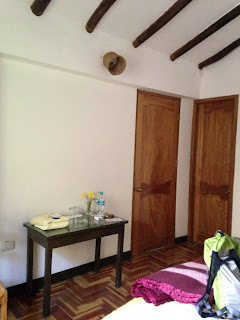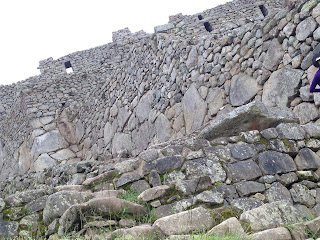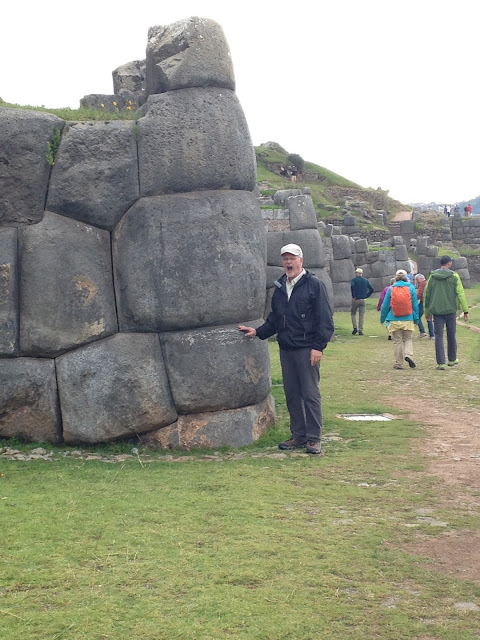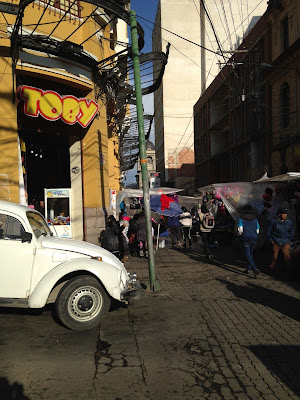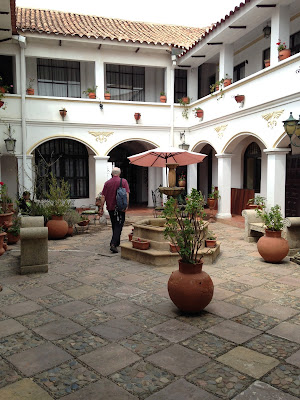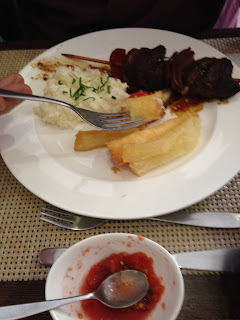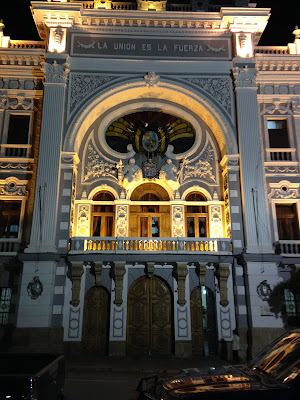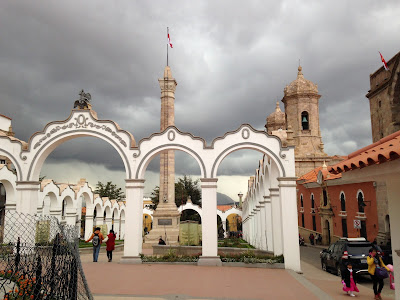With several successful trips under our belts, we decided that for our 2017 trip we would go to South America! Since it was the 40th anniversary of Tim being a missionary in Bolivia we thought that would be a good place to visit and rounded it out with Peru! So hold on to your seats!
Peru and Bolivia in 14 days!
Day 1 Saturday, April 1: Poulsbo WA to LA to Lima Peru!
Our journey started on a gray and rainy day in Seattle. Surprise! April 1, 2017 we headed for the airport in the late morning to store the car and settle in at our gate for the flight to LAX. Tim had started planning this trip about a month after we got home for the last one, so he was soooo ready to go! He had prepped his Spanish and was excited to visit the area in La Paz that he had once served. I was excited too, but mostly just for the adventure! My Spanish had not particularly improved.
 |
| Ferry to Seattle to SeaTac |
All was slick and easy! We got to LAX with plenty of time to kill. After a Panda Express dinner, we waited to board our overnight Latam Airways flight for South America. By the way...nice airline! Lots of leg room and they fed us dinner and breakfast and it was all yummers! The stewards all wore uniforms and hats the reminded us of 1960 something movies. After our meal, they tucked us all in for the night with pillows and blankets and a movie and we were off!
Sunday April 2 Lima, Peru to Ollantaytambo via Cusco
Ollantaytambo is the most common starting point for the famous Inca trail. Both fortress and temple, these spectacular Inca ruins rise above the village of Ollantaytambo. The huge, steep terraces that guard these spectacular Inca ruins make one of the few places where the Spanish conquistadors lost a major battle.
Eight or so hours later we were in Lima sufficiently rested to locate our connecting flight to Cusco. Our flight to Cusco wasn't long and before you know it we were on the ground looking for our ride to Ollantaytambo, Peru, in the Sacred Valley.
 |
| View of Cusco from our Taxi as we are heading to Ollantay |
The taxi climbed out of Cusco and we caught a view of the city that we would come back later to in our trip to explore. For now we had a reservation for Machu Picchu and kept moving towards that. The terrain to Ollantay was green rolling hills and very beautiful.
 |
| Taxi ride and driver were great! |
As we got closer to the Sacred Valley, we kind of thought that perhaps we should have planned more time to explore ALL of the ruins and sights there, but maybe on another trip!
 |
| Getting into the Sacred Valley |
As we would learn, Ollantay was not going to disappoint us! The driver took us straight to our hotel were we got settled in and then went out to see what treasures this little town held for us.
 |
| View as we came into Ollantay |
Tim is the accommodations whisperer! Our room was fabulous and $40. They do not have heating in Peru which our kids warned us about, so we came prepared with long johns. The bed had a super-warm, super-heavy, alpaca blanket on it (with a spare on the chair) and we were cozy and warm.
 |
| View towards Machu Picchu from our window |
 |
| View to the East from our window |
 |
| The balcony out the front door had a nice table to sit at too. |
 |
| Rivers everywhere raging from the rains. |
It was past lunch time so we went to the town square to see what would be good. We found a fun place and we enjoyed some Quinoa soup that was super tasty.
 |
| Lunch time view up to the mountain. See the face carved in the mountain? |
After lunch we went exploring. The village is super quaint and I think a lot of people just rush through on their way to the train station for Machu Picchu. We were glad that we had time to see it before leaving the next day.
 |
| Homes were built right on top of ancient ruins and they still used the same water systems today. |
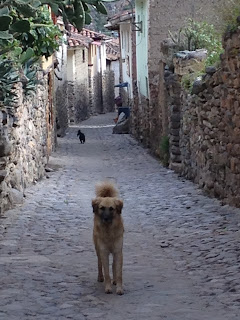 |
| Dogs are everywhere. |
So this candy (below) has a story. When Tim was on his mission in Bolivia he loved these things! When he located them in our first tienda stop for goodies, he squealed like a little boy. They are yummy and we ate...um...lets just say, more than one of them during our trip.
It was getting late and the day light about done, but the ruins at the end of town looked really interesting. We decided that would be a priority in the morning.
 |
| The young woman is spinning llama wool into thread. |
 |
| These adorable sisters let us take their picture. |
Day 3 Monday Ollantaytambo to Aguas Calientes
Our train reservation wasn't until 3 pm so we got up early to explore the ruins in town before all the tourists arrived. They did not disappoint and we had them basically to ourselves! This ruin was the last stand of the Incan people when the Spanish came. The rebellious Manco Inca had retreated to this fortress after their defeat at Sacsayhuaman. In 1536 Hernando Pizarro, Francisco's younger half-brother, led a force of 70 cavalry men to Ollantay, supported by large numbers of indigenous and Spanish foot soldiers, in an attempt to capture Manco. The conquistadors, showered with arrows, spears and boulders from atop the steep terracing, were unable to climb to the fortress. In a brilliant move, Manco flooded the plain below the fortress through previously prepared channels. With the Spaniards' horses bogged down in the water, Pizarro ordered a hasty retreat, chased down by thousands of Manco Incas' victorious soldiers. Next attack however, the Spanish returned with four times the cavalry force and Manco fled to his jungle stronghold in Vilcabamba.
 |
| There is a tourist market just outside of the entrance gate to the ruins of Ollantaytambo. |


 |
| This is not the river they dammed to flood the valley, it is just an irrigation canal. |
 |
| Looking across the valley to some ruins on the other side. |
  |
| Looking up to the fortress on the cliff. |

 |
| These ruins are right next to the town on the mountain. Looking back at Ollantay you can see the pass up the Sacred Valley. |
  |
The construction is truly amazing. You cannot even slide a piece of paper between these stones!
|
Though Ollantaytambo was an effective fortress, it also served as a temple. The stone for Ollantay was quarried from the mountainside 6 km away, high above the opposite bank of the Urubamba River. Transporting the huge stone blocks to the site was a stupendous feat. The Incas' crafty technique to move massive blocks meant carting the blocks to the riverside then diverting the entire river channel around them.
.  |
| We learned later that the Inca stone masons would carve the opposite rock so it would fit in the T or sometimes they would pour brass in to act like a clip to hold rocks together. |
The construction was amazing, with ways to control the movement of water off the face of the rock, and how the rocks were joined so perfectly, I think we have lost more knowledge than we have gained over the centuries! Some of the knobs could have been used to hold rope as they moved the rock from the quarry across the valley. Fascinating stuff.
 |
Over Tim's left shoulder is the pass to Machu Picchu.
We are standing on the Temple of the Sun. |
 |
| You may be wondering why the doorways are not rectangles...the angle helps structures to withstand earthquakes better! More slide and less jar and bounce! |
 |
| Cubbies over the soldiers beds perhaps? |
 |
Probably a place for food storage.
Put the grain in at the top and windows below to take it out. |
  |
| All the fountains still work on their original water sources. |


Tim is pointing at the channel carved in the rock for the water to flow in!
 |
| Cows don't seem too impressed with the ruins. |
It was a fascinating morning, speculating on how and why the way things were in the ruins. As we came out, the town was starting to fill up with tourists.


We still had some time so we decided to see if we could find a way up to the ruins on the opposite side of the town, by the face that we had seen yesterday.


 |
| While we were sitting in the square, this lady wanted us to purchase one of her knotted bracelets. I didn't, but instead I offered to pay to take her picture. Perfect! Win, win. |
After a little hunt and peck, Tim found the trailhead up the other side of the town. In climbing up, we realized that there was a lot more town up the river!
 |
| It was a bit up hill! The altitude was already killing us; this is like climbing up to a base camp on Rainier! |
 |
| This is on the north side of the mountain. The waitress in town said it was Incan refrigeration facility. |
After the hike, it was time to collect our packs from the hotel and go down the hill to the train for Machu Picchu! On the way, we saw the kids coming home from school! As far as we could tell, they all wore uniforms.
We were a bit excited, so we were at the train early enough so see it pull in and unload passengers. This train takes you along the Urubamba River to Aguas Calientes where we have a room for the night.
 |
| Peru Rail Station |
The seats were numbered and ours were like number 3 and 4! However, the seats were two sided and we were facing backwards! But the view was still awesome! There was a table between us and the next set of seats, and the train personnel even provided a tasty snack and beverage! The river was swollen from the rains and looked truly dangerous--like if you fell in you were a goner kind of dangerous.
The train ride was about an hour and a half and we enjoyed the views of homes, farms, and more ruins all along the river on the opposite side from the tracks. We pulled into Aguas Calientes and after some hunt and peck we found our accommodations for the night. Once again, stellar choice-- $45. Right next to the river, the lobby was open to birds and sounds, but our room was relatively quiet with the window closed.
 |
| The view from the lobby. |
 |
| Our dinner for the evening. Upper is a Peruvian dish with sauce and lower is stuffed chili rellanos, fried potatoes and a tasty salad. We ate it on a baloncy and watched people for a while. |
Aguas is a boom town of sorts. As you walk up the main street it is a guantlet of invitations to dine here, drink here, etc. It is really kind of hard to choose! After dinner we strolled a bit along the river and found this recent carving--not ancient, but cool in the lights.
Day 4 Machu Picchu
Machu Picchu is a 15th-century Inca citadel situated on a mountain ridge almost 8,000 feet above sea level about 50 miles NW of Cusco, the Incan capital. The Incas built Machu Picchu around 1450 but abandoned it a century later at the time of the Spanish conquest. Although known locally, it was not know to the Spanish during the colonial period and remained unknown to the outside world until American historian Hiram Bingham brought it to international attention in 1911. Voted one of the New Seven Wonders of the World it became a UNESCO World Heritage Site in 1983.
We were warned that visiting Macchu Pichu was either going to be wet or a major sunburn. The weather was perfect, overcast but not wet, and the sun came out later. We got up there by about 8 am and almost had the place to ourselves for several hours. No photo bombing!
 |
| Lawn care team of llamas. |
 |
| The local guide joke was pointing to the Inca construction, then pointing to the Spanish reconstruction. Inca's knew how to build with rock and no mortar! |
When Tim visited in 1979 on the way home from his mission, Machu Picchu was only about 30% excavated. More has been reclaimed from the jungle, with some reconstruction.
 |
| Tim was here on his 21st birthday, January 17, 1979, coming home from his mission! |
 |
| There was a pile of these rounded peg type stones. See next picture... |
 |
| The rounded peg stones were used to hold up timbers for the roof. |
 |
| The quarry |
 |
| (Nobody is jumping, a bug is on the lens!) Look in the greenery on the hill. People are climbing up that! |
 |
| We sat on this rock, with our legs hanging over the edge and ate a snack. |
 |
| My mountain man! |
 |
| Two story house with a bathtub! |
 |
| Once again, the control of water moving over the surfaces. |
 |
| This was our vantage point from where we ate lunch. Our hotel packed up a very nice lunch. |
We spent probably 7 hours up in the ruins, but eventually we were tired and sun burned and we went back to Aguas for a snack and to retrieve our bags from the hotel. Our train out of Aguas was supposed to leave at 3:30 and we would be getting into Cusco on the late side we. At least that was the plan!
 |
| The rock cliffs seems to rise right out of the edge of the town. |
We got to the train station and organized ourselves, expecting a short wait. Several hours later we learned that there had been a mud/rock slide on the tracks and we would have to wait until it was cleared and the tracks checked by officials. The was not way to predict the train schedule so we stayed in the station. At least we had chairs, many did not.
We finally arrived back in Ollantay at about midnight. Gratefully all of the buses and vans and cabs were waiting. Tim literally grabbed the first taxi driver that would drive up to Cusco and we were off! At about 2 am we made it to our accomodations in Cusco---they had waited up for us to let us in! So grateful!
Day 5 Wednesday Cusco and Bus to Puno
Cusco is the historic capital of the Inca Empire from the 13th Century until the 16th century Spanish conquest. Another UNESCO World Heritage Site, Cusco is generally temperate with two distinct seasons: wet and dry!
Our accommodations too were nice, although we weren't there for very long! A few short hours later we were eating breakfast and stowing our bags again. This time we were going out to explore Cusco before we needed to meet our bus to Puno! Phew!
 |
| Twin beds! |
  |
| Masks on the wall, probably for Carnival. |
  |
| I love how Peru keeps the old and just works with it! Floors and Walls were rock. |
 |
| Between the two white buildings is an LDS Chapel... |
 |
| San Pedro Market |



We had a wonderful glass of freshly made juice in this market. Tim had a nice chat with the lady. She liked us so she gave us what was left in the blender too! Yummy and very filling!
 |
| This make me think of the Abby Road album cover for the Beetles! |
 |
| Plaza de Armas |
 |
| Plaza de Armas |
  |
| There was actually a Starbucks in the plaza. |
 |
| New buildings built on top of the Incan ruins. |
 |
| As best as Tim could remember, he spent the night in this hotel 40 years ago! |
As we were walking down the street, these lovely ladies basically jumped me as I commented on the cute lamb....they tossed the lamb in my arms and quickly posed for a picture--which we paid them for. They tried to do the same thing to Tim and he just held his hands up and would not touch the lamb! Love the picture!
 |
| Up away from the city center, the streets are narrow, but the cars still go down them! |
 |
| That is Tim standing back in a doorway while the cars go by! Narrow for sure! |
 |
| San Blass was an up-scale, boutique part of town. |
 |
| Upscale and crowded |
 |
| We met our guide here for our tour of Cusco. |
After wandering a bit, it was time for our official tour of the city. We met up with a larger group, one man traveling by himself because his wife did not want to hike up the Inca trail; something he always want to do. We toured the inside of this church. Then over to Koricancha.




Koricancha contained the Temple of the Sun, a sacred site in the Inca religion and was considered the very center of the Inca world. Legendary stories tell of the enormous quantity of gold used to decorate the temples and its golden garden statues. The Spanish colonists built the Church of Santo Domingo on the site, demolishing the temple and using its foundations for the cathedral. Construction took most of a century. Major earthquakes severely damaged the church, but the Inca stone walls, built out of huge, tightly-interlocking blocks of stone, still stand due to their sophisticated stone masonry. The Spanish could not or did not get the larger blocks at the base of the temple removed, so they built the cathedral right on top. Centuries later, after an earthquake, the Inca ruins were discovered under the cathedral when the plaster was dislodged. They found what archaeologists named--the temple of water (underground baptism me thinks), temple of stars, moon and sun....are you thinking what I am thinking?
 |
| They had an elaborate explanation for this large silver plaque, all I saw was a version of the plan of salvation. There's Adam and Eve, degrees of glory, tree of life, all kinds of similar things! Maybe its just the seminary teacher in me. |
 |
| Condor, snake, puma (heaven, underworld and earth) |
 |
| The large blocks at the bottom are the base of the Inca temple. |
 |
| You can see the two structures better from the front. |
 |
| I didn't take pictures of all of the rooms, but this one actually had space to let in the sunlight. |
After sometime in Cusco, we climbed into a van and went to see the awesome ruins of Sacsayhuaman on the outskirts of Cusco. The pictures do not really capture it, but I tried! Foundations were built in a zig-zag to symbolize lightning. Following the siege of Cusco, the Spaniards began to use Saksayhuaman as a source of stone for building Spanish Cusco. Much of the site was taken apart and demolished. Today, only the stones that were too large to be easily moved remain.
 |
| These stones are just the foundation work. |
 |
| This was not part of the site, just next to it. |
 |
| View of Cusco |
 |
| More lawn mowers! |
 |
| Lupine |
Qenqo is another site a short driving distance away in a large rock formation located a short distance from Sacsayhuaman. Experts believe that the caves and niches we saw might have been used to prepare and store mummified bodies for burial. People were embalmed and placed in a fetal position. They believed in the resurrection as a re-birthing process.
 |
| Between these rocks we went a short distance underground. |
We were then driven to another nearby ruin, Tambomachay where some royalty was buried. They had a guard's post nearby and dead guards guarding their spirits. This place was also nicknamed the "Bath of the Inca" due to thermal waters which are channeled through a series of intricately designed stone aqueducts and canals from an unknown source. The fountains still work and the water is supplied by an ancient system of underground channels.
We were getting rained on, but we came prepared with umbrellas and rain gear. Our last stop was at a guard tower that watched the Inca trail between Cusco and the Sacred Valley. Pucapucara looked a bit like a European castle.
 |
| Great view. |
Before we knew it our tour day in Cusco was done and we were looking for our overnight bus to Bolivia!
Day 6 Thursday Puno, Uros Islands on Lake Titicaca, and Copacabana, Bolivia
On this part of our trip particularly, we felt like the cool old people traveling with all of the twenty something backpackers that had been traveling for months, or maybe even years. They chatted us up and were really friendly. It made us feel honored in a way!
Before taking us to the boarder, our bus stopped outside of Puno for breakfast, then we boarded a boat to take us to the floating Uros Floating Islands on Lake Titicaca. Totally man-made islands that float on decaying reeds in Lake Titicaca. We got to visit some homes and learned that the children are basically home-schooled and they make use of solar power. We also got to ride in one family's "Cadillac" -- a reed boat, over to another island where our boat picked us up and took us back to the bus.
 |
| View across to Puno, Peru |
 |
| Our transport out to the island. |
 |
| You have to have permission to enter. |
 |
| In the distance our destination. We are traveling through channels in the reeds. |
Boarder crossing was really interesting. Our bus stopped outside of the border offices in Peru. We had to get an exit stamp. That was easy enough. Then we had to cross the border on foot (the bus was not allowed to cross.) We next entered the Bolivian border crossing office with our required (and extra) paperwork. Tim had prepped everything in advance so, when the guard requested a copy of our passports, we already had them and we breezed through. Other's on our bus had to jump through the extra hoops by making copies at the locale tienda. Another bus was waiting for us on the Bolivian side. When everyone was through, we made our way on into Copacabana.
Copacabana is the launching pad for visiting Isla del Sol and is a pleasant stop between Puno and La Paz. Our bus got us to Copa with just enough time to find our hotel and get back for our tour boat out to Isla del Sol, the birthplace of the sun.
 |
| Isla del Sol |
There are no vehicles on Isla del Sol, so we hiked along rocky trails from the south to the north end of the island. People, mostly indigenous, live on this island with their animals. We passed a train of donkeys moving supplies up from the port, all without much human intervention; they seemed to know the way to go. This island is identified as the birthplace of several revered entities, including the sun itself. Legend has it that the bearded white god-king ( sound familiar?) and the first Incs, mystically appeared under direct order from the sun. Most modern-day Aymara and Quechua peoples of Peru and Bolivia accept these legends as their creation story.
We didn't get much time to explore on this island, our boat was waiting when we got around to the pick-up point. The boat was really slow moving. We found dinner in a shop up the main street a short distance from the lake and then we made our way up to Hotel Cupala. Tim scored again. Very cozy and this time we got a heater!
 |
| Copacabana |
 |
| Fuschas! |
  |
| Another great find for $40 |
 |
| Views out to Lake Titicaca |
Day 7 Friday: Copacabana to La Paz Bolivia via Tiquina Strait
Nestled between two hills on the southern shore of Lake Titicaca, is Copacabana. A small, bright and enchanting town. It has long been a religious mecca with mostly local pilgrims flocking to its fiestas. Cerro Calvario starts at the church and climbs past 14 Stations of the Cross, each one depicting an event in the Crucifixion of Christ. People believe that if they climb up this hill on their knees, carrying a rock (the bigger the rock, the bigger the sin), they will be forgiven that sin. Easter is a big time for people to join the pilgrimage to the top.
 |
| View of Lake Titicaca from the trial up. |
 |
| View from the climb on Cerro Calvario looking down to the church in Copacabana. |
 |
| Remember we are climbing while already at finger tingling altitudes! |
 |
| There were places to light candles at the top. |
 |
| We had some time before loading our bus, so we went to locate where in town we would need to be. |
This Moorish style cathedral had domes and blue Portuguese style ceramic tiles.
 |
| Inside the altars were intricately carved wood covered in gold leaf. |
 |
| Tim and I enjoyed some Saltanas, a delicious mix of meat, potatoes and spices in a hand held pie. |
 |
| Somewhere along the way, Tim lost the hat he brought on our trip. We had purchased a replacement in Cusco, but he wasn't happy with it. At this altitude, he would burn fast, even with sunscreen. He wasn't feeling the ball cap, so we stopped at a hat shop and he picked this beauty! |
 |
| This gives you and idea of all the bags we carry. That's it! It helps limit how much we can buy along the way! |
The next leg of our journey was soon to begin. In town, we had booked a bus that would take us into La Paz across the Tiquina Straits on Lake Titicaca.
 |
| Beautiful countryside views. |
 |
| Our bus |
Everything has to be barged across the Tiquina Straits, including our bus! We excited the bus and made our way to small boat launches. Once again, in true latin style, we were loading in nice and tight to cross and await our bus.
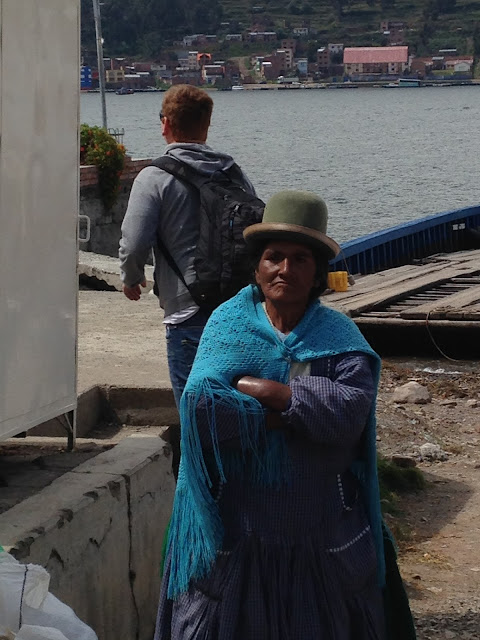 |
| Although I pretended to be taking a picture of the barges, I was taking this gal's picture. I do not think she was fooled! |
 |
| Bus on the barge. |
 |
| Everything, even cars and trucks. |
When the bus was once again filled with it's passengers, we made our way to La Paz. As we came to the Alti Plano, it was market day! The people and stalls and shear mass of humanity came right up to the edge of the two lane road and we consequently inched along.
 |
| You can see that money is starting to move to the indigenous people, as evidenced by the large buildings and houses under construction. |
 |
| Che |
 |
| First peeks of La Paz |
 |
| We noticed a parade or festival of Cholitas in one of the neighborhoods. |
 |
| La Paz bus station was designed by Eiffel. |
The bus station was huge and well organized. It was still daylight, so we decided to walk the few blocks to our hotel in the historical district.
 |
| Views from the overpass |


We were right in the heart of the historical district a short walk from Iglesia de San Francisco. It appears that the bowled city either goes up or down; there is not much flat! Tim and I had been taking altitude pills since or trip began and we were glad to have them! Our room was quiet and away from the city noises and very comfortable. It was easy to find a place to eat too, either right in the lobby or two doors down!
  |
| This international restaurant was frequented by all of the young backpackers and the food was good! |
 |
| Tim is trying a llama burger. |
Day 8 Saturday La Paz Bolivia
I think La Paz was well described by our guide book: " A mad carnival of jostling pedestrians, honking, diesel-spewing minivans, street marches and dances and cavalcades of street vendors, La Paz surrounds you: you'll love it, you'll hate it, but you cannot ignore it. The city seems to reinvent itself at every turn - a jaw dropping subway in the sky brings you from the height of El Alto to the depths of Zona Sur in the blink of an eye. It is the urban jungle baby: diesel, dust and detritus; blinding altiplano sun; sharp-suited businessmen along side machine-gun toting bank guards; and Gothic spires battle with glass hotels. La Paz amazes and appalls all who enter!
 |
| Iglesia de San Francisco was our meeting place for our local tours. |
Our guide told us that Iglesia de San Francisco was started by monks. Typically the Catholic Church forced the early people into being Catholic, but the monks were unique in that they accomplished the transistion of worship by tricking the people. After a couple of hundred years, the monks did not have many converts, but by paying attention, they noticed that after an Indian had been scared or startled, they would say their name three times while motioning for their spirit to return to them. The Indians believed that that feeling you get when you are surpirsed meant that your spirit had left you. Without your spirit you would get sick and eventually die. So they would invite the spirit back.
The local indigenous people helped to build Iglesia de San Francisco with their masonry skills, carving into the facade representations of Pachemama, etc. This took a lot of time...here comes the trickery part. The monks would walk up to an Indian and say, are feeling well? You look sickly. Have you lost your spirit? You spent so much time in our church with the building of it, I think perhaps your spirit got used to it and is still there. Perhaps you should come and visit it there. So the Indian would come, and see him or herself in one of the many mirrors inside! The monks would then convince them to come and visit their spirit often to stay healthy; a catholic is born.
 |
| Witches market |
 |
| These gals were selling tickets for Cholita wrestling. |
The city of La Paz is basically in a bowl shape and the traffic and people crunch is amazing. So in 2014, under Eva Morales the first native Bolivian president, the Telferico, the world's longest aerial cable-car system was built. Tim arranged to have a tour of the system. We started our tour in Supu Kachi station, which was originally a train station.
 |
Our tour guide Mauricio told us that the cables of each line were raised using a drone.
This is a poster board of the drone in action.
|
The cars are extremely clean and well kept. The cars move continually and you step on and off at each station. There is a guard that checks each car to be sure you leave it looking nice. Riders can combine trips from the yellow to green lines to get to the Zona Sur from El Alto, but you must pay the fare twice--there are no free transfers. Six more lines are slated to be implemented in the coming years. The lines are named for the colors of the Bolivian flag (red, green, yellow).

The thrill of riding above La Paz' swirling traffic and canyons was undeniably cool. It was raining the day we took our ride so the pictures aren't great. Our guide Mauricio pointed out the different neighborhoods and sites as we quietly soared overhead. The rich folks are not pleased to have people able to have full view of their back yards, for sure; there is considerable push back for the project. The full ticket price is beyond the average native, so the fares are reduced for the next few years. The growing middle class will be able to afford the fee. You can get across the city in a manner of minutes instead of sitting in traffic and fumes. I thought it was grand.
El Alto station. Each station was really nice.
Adobe homes are being quickly replaced by rebar and brick homes, which is a good thing, considering that the adobe is infested by a beetle that makes the people sick for their whole lives. Progress is coming to the poor of the city.
 |
| Although recovering from getting sick, Tim opted to not eat any dinner this particular evening. |
 |
| Generally we felt safe at night because there were lots of people out. We did have one guy yell at us, basically accusing us of being CIA. |
Day 9 Sunday La Paz
We were really excited to attend church in the branch (now a ward) that Tim served in 40 years ago. We got up early to get a taxi, and discovered there was a marathon going on...at this altitude! We were taking altitude pills (which we highly recommend) and these folks were running. Big lungs! This procession went on and on! We basically had to wait for a small break in the mass and run across to get to where we were going. Thousands of people participated.
 |
| This was Palm Sunday and lot of people were constructing beautiful crosses and flowers using palm leave to sell to people. |
It was Fast Sunday, a day when people in the congregation share their testimonies. Tim was excited that he would be able to take a minute and share his love for the people and his identity as an early missionary in the area. We were made to feel so welcome; the Mira Flores ward put a lot of US wards we have attended to shame. They made sure that we stayed the whole three hours, (even got me a translator.) Just 50 years ago the area was dedicated for missionary work; they have come a long way. Turns out, that the ward Tim worked in for six months met on the later schedule, so after some lunch we returned for Sacrament with them.
 |
| It was pretty new when Tim lived here, but he was pretty sure that this building was where his apartment was in 1977. |
Although we took a taxi to church, we walked back. It wasn't that far and we enjoyed seeing the area slowly.
 |
| The people are feeding the pigeons. They would put bird seed on their body parts and try to see who could get the most pigeons to land on them at once, then take pictures. |
Being Palm Sunday the streets were quiet for a while in the am. As the day went on, the street filled up again with people, stands, and cars.
Day 10 Monday La Paz to Sucre
Early in the morning we grabbed a taxi to take us to El Alto for our flight to Sucre. He was a slick driver. Using back roads and STEEP little streets he got us to the air port quickly.
 |
| View as we come out of La Paz up to El Alto. |
 |
| Lots of old airplanes parked along the runway. |
 |
| The airport looked newish. The topiaries in the front are of llamas and the heads have not completely grown in yet! |
We got there in plenty of time to check in and get some breakfast before our flight.
The Alto is really flat and we were finally able to view the Andean Mountains around the airport.
The plane stays on the runway a long time at this altitude! Just as you begin to wonder the plane lifts off the ground! It wasn't long and we were in Sucre! Tim knew just what to do (of course), and we walked out of the air port, past all of the taxi drivers to where the locals go to get into Sucre.
We climbed into the local bus, about a 10 passenger van equipped to hold 15 or so and drove several miles into town.
Genteel Sucre is Bolivia's most beautiful city and the symbolic heart of the country. It was here that independence was proclaimed, and although now, La Paz, is the seat of government, Sucre is recognized in the constitution as the nation's capital.
White-washed buildings sheltering pretty patios and wealth of colonial architecture, Sucre really is a show-place and a well deserved UNESCO World Heritage site since 1991.
Set in a valley surrounded by low mountains, Sucre enjoys a mild climate. The parks were beautiful and well kept. There are an impressive number of museums, colonial buildings and ornate churches.
 |
| Casa de la Libertad place where the Bolivian declaration of independence was signed in August 6, 1825. |
We got to Sucre fairly early, so we checked into our accommodations after some exploring. Another great place to stay found by the master, Tim. Lots of character for just $40. Our rooms were in the back away from the noise and very lovely.
  |
| Views |
Once we had ourselves settled, we went out exploring and found where the locals shop.
 |
| The photo is blurry, but this is a line of elaborately decorated cakes ready for sale. |
We finally decided on a nice place for some lunch. It was the special of the day and was a three course meal (and very yummy!) I think it was $4 each.
I always love the portion size south of the border. They are smaller than ours, but you are not hungry when you are done and don't have that stuffed feeling. I think our dessert was cheese cake.
Back in the day, when you needed cash you would have to find a place (usually a bank) to cash traveler's checks. Today, even in Bolivia, you use a bank card. Usually you have a private space to do your electronic transaction, like this one, with a locking door. It helps you feel secure while getting organized and gives some space to figure out how to do the transaction correctly! Cash in pocket, we were off to explore Sucre some more.
 |
| A miniature of the Eiffel Tower was tarped up for renovation. |
We came across a cemetary and took a walk around. Each crypt had a display case that people could place remembrances, candles, pictures etc. Yes, they are stacked. There were lots and lots of these. Turns out, that you have to pay a yearly fee for the maintenance of your deceased loved one!
 |
| This is a family crypt. |
 |
| This is a separate section for German Jews who fled to Bolivia. |
 |
| The infant cemetery was sad. |
As we were hiking up for a great view of the city, we found an LDS chapel and peeked around.
 |
| View around the chapel |
Churches and cool buildings everywhere! As the sun went down, the buildings around the main square were lit up.
 |
| Statue of General Sucre for whom the city is named. |
Day 11 Tuesday Sucre to Potosi
Our time is going so fast! It was great that our hotel also provided breakfast. It was fun that it was in such a grand room! The typical breakfast was bread, butter and jam, fruit and yogurt and coca tea or fresh squeezed orange juice. They did have granola, but it was basically cocopops!
We had some time before leaving to tour the Casa de la Libertad.
 |
| Inner court yard |
 |
| Copy of the Bolivian constitution. Under Morales, the indigenous people are now recognized for their participation in the revolution and their pictures have been added. |
 |
| Our English speaking guide explained that this balcony was for women when congress was in session. |
 |
| This was a unique cannon. Designed to be moved on horse-back; no wheels. No they did not shoot it from the back of the animal! |
Day 12 Wednesday Potosi
The conquistadores never found El Dorado, the legendary city of gold, but they did get their hands on Potosi and its Cerro Rico (Rich Hill) full of silver. The city was founded in 1545 as soon as the ore was discovered and pretty soon the silver extracted here was bankrolling the Spanish empire. Even today, something very lucrative is said to vale in Potosi (be worth a Potosi). Potosi became the largest and wealthiest city of the Americas during its boom years.
We had fun working out the bus from Sucre to Potosi. We had pre-paid for our bus tickets and knew about the terminal tax. What we did not know about was that we still had to check in and get a seat reservation! When our bus arrived, we got comfortable in a couple of seats, only to be moved several times by those that had reserved seats. Fortunately, the bus was not sold out and we did not have to stand all of the way to Potosi-about 3 hours! We were in the back of the bus and I am sure some people enjoyed watching us get continually bumped back! The views out to Potosi were awesome though!
The bus terminal in Potosi was huge and equipped to handle many buses at one time. It was kind of eerie quiet when we arrive however. Only the shouting of the vendors and lots of echos! We found a bathroom then exited the terminal and located a taxi to take us to the Air B&B Tim had found on-line.
Our taxi driver had a hard time locating our address for the night. At least he got the right neighborhood! A kind neighbor assisted us to find the correct bell to ring and we grateful! We had this great little apartment, complete with kitchen and bath all to ourselves. We were glad that the bedroom had a heater, it got cold at night! I will mention that the hot water, wasn't, and we had to shower pretty fast! But otherwise it was nice! Again about $40.
No one knows for certain how much silver has been extracted from the mountain, but the popular boast was that the Spanish could have constructed a silver bridge to Spain and still had silver left to carry across it. There is still mining done. The mine conditions are abysmal and we did not go there. The rest of Potosi with its grand churches and ornate colonial buildings is worth getting to see. In 1987 Unesco named Potosi a World Heritage site.
 |
| Setting up for Easter |
We discovered that it was children's day in Potosi! The kids gathered in groups, dressed according to a theme and paraded around the square, band and all. Then there were fun games and activities for the kids. They love their brass instruments!
The National Mint is Potosi's star attraction and a great museum. The building was built between 1753 and 1773 to control the minting of colonial coins. These coins, which bore the mint mark "P", were known as potosis and later that "P" became the $ sign. The guided tour took about two hours.
 |
| We had to wait a bit for our English tour to begin. |
Immense mule drive wooden cogs that served to beat the silver to the width required for the coining. These were replaced by steam-powered machines in the 19th century. The last coins were minted here in 1953.
 |
| Silver bars were placed in the slot and pounded systematically by the rotating spine. |
 |
| No nails, everything still works! |
 |
| Animals are not real! You could see where the stones were worn from their feet. |
 |
| Transfer gears from mule power up through the floor. |
 |
| After the mint closed, the building was used as a jail and later as headquarters for the Bolivian Army. |
 |
| Because the silver had to be transported over land by mule and then across the Atlantic by ship to Spain, elaborate locks and sturdy boxes were constructed. This one is a combination lock. Each lock having a specific key that had to be turned in a specific order. |
 |
| This huge example of amethyst was taken from Cerro Rico |
 |
| Molds for silver ingots |
 |
| Museum had this display to illustrate that the refining of silver from the ore was done by hand by the indigenous peoples. They did not live long being exposed to all kinds of hazards. The rock walls were black from the soot alone. |
 |
| After mules, then steam power was used. |
 |
| After steam engines, then electric engines were used to power the massive wooden cogs. |
 |
| Another view of Cerro Rico from downtown. |
There are tons of churches in Potosi, each with its own character and style. Some ornate, some more rustic.
 |
| We saw this fun sculpture of a famous guy who tilted at windmills! Actually Don Quixote was so popular that the book helped to standardize the Spanish language! |
We found out that we could take a tour inside of Convento de Santa Teresa founded in 1685. Girls of wealthy families entered the convent at the age of 15, getting a last glimpse of their family at the door.
Up a tiny staircase and we got to see the top of the church and a great view of the city. My battery died so this is all we have!
Were spent two nights in Potosi and had a great time there, getting caught in a gully washer twice! We had umbrellas, but both times we had left them our room!
When it came time to head to the tiny Potosi airport early in the morning, it turns out our flight was cancelled! But fear not, they had great costumer service and paid for a taxi to take us to our next destination--the airport in Sucre for La Paz!
Day 13 Thursday Potosi to Sucre to La Paz
 |
| Bolivia Air |
Tim lived about seven months in Mira Flores. It was fun to see him navigate and remember and be surprised how La Paz had changed in the 40 years since he had been there. He really had not expected anything to have changed over the years; Bolivians had been taken advantage of for decades, so generally, nothing ever seemed to change. It was great to see improvements.
 |
| Mira Flores Plaza Murillo |
 |
| Elder Bullock's mission home |
 |
| Like other Latin countries we have visited, La Paz is a mix of old and new. As you get out of the center of the city, life runs at a calmer pace. |
La Paz has great inexpensive tours. We booked a food tour for the evening to taste some local street food. We really should have heeded the warning to come hungry...We enjoyed hapi, a local drink served warm made from purple corn and some tortillas and cheese--yummy. Then a fruit smoothie. Those were the appetizers....
 |
| Night lights of La Paz |
 |
| Street cooking |
Then a pork dish covered in sauce at another restaurant, and finally a vinegar-meat dish and veges at yet another pub-type establishment that had great live music. It was a fun evening and we were so full. The people of La Paz are very proud of their city and love to show it off!
This time we stayed in a hotel in La Paz that Tim used to walk by all of the time. It was newish in the 1970's and had seen some grand days. It was actually quite nice, but we were back to twin beds again! The people partied in the street outside until about 2 am, and being several flights up helped. This would be a great back-packer hotel!
 |
| Night views from the hotel |
 |
| Nice clean hotel for $40 with bottled water right in the hotel! |
Day 14 Friday La Paz to Lima
Another early run to the El Alto airport to catch our flight to Lima!
 |
| International Departure Lounge in La Paz. |
We had one day in Lima and it is a big city. We had time before our tour of the city to wander and get some lunch in the Grand Bolivar Hotel.
Plaza San Martin, Lima
Our walking-tour guide took us through the historical district of Lima. Lot of old buildings that they are struggling to restore and maintain. This one at one time had lots of squatters and a fire.
The body crunch was pretty intense. It was Good Friday and the religious Catholics had to visit 15 churches in one day as part of the tradition. It was crazy! Our guide was great and she was in no hurry to take us around!
Only licensed vendors were allowed to sell their goods on the street. They had sanitation "police" that made sure that people complied. The buildings in Lima were really old and many had balconies. The buildings with balconies once belonged to the rich and were used so the young rich ladies to peek out onto the street to watch people. Their women were very sheltered. To preserve the balconies the city was asking different organizations to adopt a balcony and restore it. Many were very ornate.
 |
| There were many times I got separated from the group and was glad that Tim was tall and had on this hat! |
Being Good Friday, some places were opened that usually weren't and we got to peek inside. This was once a residence. Lots of ornate wood carving.
 |
| Even the ceilings above the carriage entrance was decorated. |
Lots of churches, some of which we walked through while mass was going on. Crazy.
 |
| Yup, many Chinese-Peruvians; thus China Town |
We were a little disappointed that we couldn't go inside this church. We were told that it had an interesting crypt under the church.
 |
| Riot police out just in case. |
Off in the distance, along the ridge of the hill was a procession of people climbing another Calvary Hill. You can see the residences of poor Peruvians up the side of the hill.
 |
| Ruins that were discovered when this plaza was being renovated. |
 |
| Those dots are buzzards! |
 |
| You can see the stages of building. They have had some wicked earthquakes in Lima! |
 |
| Plaza de Armas, Lima. |
We ended our walking tour of Lima with virgin Pisco Sours. A tasty sour drink (usually with alcohol) topped with whipped egg whites. We went looking for some dinner in modern Mira Flores and took a walk along the coast line. Great views, warm evening and a beautiful contrast to the day in historical Lima.
When you only have a few days for vacation, you tend to rack and stack all that you try to see and do and experience. Tim and I really wished we had more time to slow down and experience each place, and we have some retirement ideas on how to do just that! The people of Latin America constantly impress us. We will be back!
Day 15 Saturday LA to Seattle!
We spent the night on our flight from Lima to LA and then to Seattle. On the drive home, we stopped in Tacoma and ate a salad at Chic-fil-a; we always miss eating salad when we go on our trips! OK....we stopped for the fries; whatever!













































































































